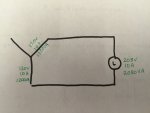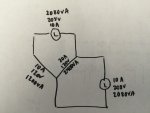You are using an out of date browser. It may not display this or other websites correctly.
You should upgrade or use an alternative browser.
You should upgrade or use an alternative browser.
120/208 3-ph, 4W panelboard amps on A phase?
- Thread starter JasonCo
- Start date
- Status
- Not open for further replies.
That is a matter of opinion. Code does not specifically state any one way. Appendix D Example D1(b) tends to make one believe the only approved method for checking imbalance is the arithmetic summing method... yet all other load calculations are done using VA.Thanks for clarification. So the solution to OP problem by arithmetic sum of load currents is correct.
...And getting back to the OP, how is that going to work with the multiple choice answers available?
...And getting back to the OP, how is that going to work with the multiple choice answers available?
Per your solution for your own problem:
A=30A, B=20A, C=10A Arithmetic sum of individual load currents
A=29.1A, B=19.3A, C=10.0A Vectorial sum of load currents
A=28.7A, B=18.7A, C=10.0A Individual load kVA summing method
the vector solution is the correct answer. The arithmetic solution is closer to it than the KVA method solution. Does it hold in the general case?
No, it does not. Consider that the problem I presented is quite unbalanced. But there is no other option for these three loads. Where loading is better balanced the KVA result will be closer to the actual value than the arithmetic sum.Per your solution for your own problem:
the vector solution is the correct answer. The arithmetic solution is closer to it than the KVA method solution. Does it hold in the general case?
wwhitney
Senior Member
- Location
- Berkeley, CA
- Occupation
- Retired
Huh? In post 103, the KVA solution is closer to the vector solution.the vector solution is the correct answer. The arithmetic solution is closer to it than the KVA method solution.
Cheers, Wayne
Good catch. I didn't make an error, but my thinking was way off in left field and thus my reply.Huh? In post 103, the KVA solution is closer to the vector solution.
Cheers, Wayne
Well, I erred. Sorry. Again, as you showed that the KVA method solution is closer to the actual solution for the very unbalanced case, does it hold in general as
Where loading is better balanced the KVA result will be closer to the actual value than the arithmetic sum.
Yes. I believe so.Well, I erred. Sorry. Again, as you showed that the KVA method solution is closer to the actual solution for the very unbalanced case, does it hold in general as
Then shall we take D as the answer to the OP's problem?Yes. I believe so.
If I had to chose one...Then shall we take D as the answer to the OP's problem?
:blink:
Isn't the answer D based on KVA method?If I had to chose one...
:blink:
Not exactly.Isn't the answer D based on KVA method?
lauraj
Senior Member
- Location
- Portland, Oregon
Jedi speak not...
Typical service calculation would use the kVA method mentioned earlier. On a 208/120 system, Line A would have the greatest draw, and that would be
(10A×208÷2)+(10A×120)+(10A×208×sqrt(3)÷3)=
1040VA+1200VA+1200VA=3440VA
3440VA÷120V=28.7A
The 1-phase 208V calculation is not correct. If you look at the windings of the wye, you have two windings with 10A, 120V giving 1200VA per winding, not 1040VA.
That gives a final calc of 1200VA + 1200VA + 1200VA = 3600VA
3600VA / 120V = 30A on A-phase
Whether you use VA or A the answer should be the same, not taking vectors into account.
It's a generic method of using approximated vectors. It has been a conventional method since before I was born... to make panel schedules, and show [approximate] balance and line current.The 1-phase 208V calculation is not correct. If you look at the windings of the wye, you have two windings with 10A, 120V giving 1200VA per winding, not 1040VA.
That gives a final calc of 1200VA + 1200VA + 1200VA = 3600VA
3600VA / 120V = 30A on A-phase
Whether you use VA or A the answer should be the same, not taking vectors into account.
If you continue with your method, you'd get 2400VA on B, 1200VA on C. Add 'em all up and you'd get more VA than is actually connected?
lauraj
Senior Member
- Location
- Portland, Oregon
- Location
- Placerville, CA, USA
- Occupation
- Retired PV System Designer
True, because the current on the windings is not in phase with the line to neutral voltage. The PF of the load can be 1 while the PF on the individual phase wires is lower.
What GD said. The power factor of the winding is equivalent to cos(30°) when L-L load has power factor of 1.The VA on the windings in the transformer is different than at the VA at the load. Check it out.
Draw an identical load between one of the used windings and the unused. What is the VA of the common winding? How much does each load contribute to that VA? This is the basis of the calculation method
lauraj
Senior Member
- Location
- Portland, Oregon
The values of your common winding are incorrect. Should be 17.32A, 120V, 2078.4A (displays rounding error; essentially 2080VA). It would be the same as if you had three identical delta-connected 10A heater loads... but just leaving one out for demonstration purposes.Smart$, is this what you mean? This is the way I've always done it for NEC calcs, just want to make sure I'm looking at it the right way.
The VA on the windings in the transformer is different than at the VA at the load. Check it out.
The windings in the transformer are never 120V at the same instance in time due to the phase shift. Their maximum potential difference, rms, is 208V at any given point in time.
I.E. 120sin (x) - 120sin (x-120) has a max value of 208, your picture is misleading.
Your picture should have 103.9V, 10A, and 1039VA on each transformer coil the moment in time the load is experiencing 208V .
Last edited:
- Status
- Not open for further replies.


